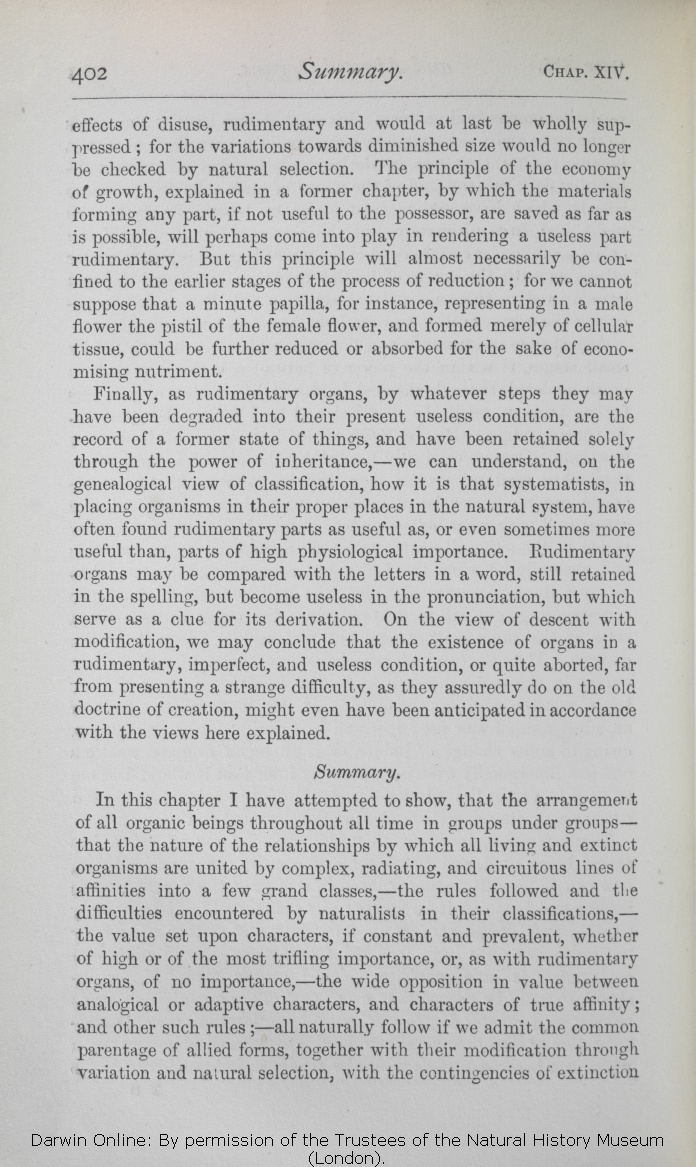|
effects of disuse, rudimentary and would at last be wholly suppressed; for the variations towards diminished size would no longer be checked by natural selection. The principle of the economy of growth, explained in a former chapter, by which the materials forming any part, if not useful to the possessor, are saved as far as is possible, will perhaps come into play in rendering a useless part rudimentary. But this principle will almost necessarily be confined to the earlier stages of the process of reduction; for we cannot suppose that a minute papilla, for instance, representing in a male flower the pistil of the female flower, and formed merely of cellular tissue, could be further reduced or absorbed for the sake of economising nutriment. |
|
Finally, as | Finally, as 1872 |
| As the presence of 1859 1860 1861 1866 1869 |
| organs, 1872 | | organs 1859 1860 1861 1866 1869 |
| by whatever steps they may have been degraded into their present useless condition, are the record of a former state of things, and have been retained solely through the power of 1872 |
| is thus due to the tendency in every part of the organisation, which has long existed, to be 1859 1860 1861 1866 1869 |
| inheritance,— 1872 | | inherited— 1859 1860 1861 1866 1869 |
| systematists, 1872 | | systematists 1859 1860 1861 1866 1869 |
| in placing organisms in their proper places in the natural system, have often 1872 |
| have 1859 1860 1861 1866 1869 |
| ..... 1869 1872 | | in seeking 1859 1860 1861 1866 |
| with 1859 1860 1861 1866 1872 | | with, 1869 |
| old 1872 | | ordinary 1859 1860 1861 1866 1869 |
| anticipated 1869 1872 | | anticipated, 1859 1860 1861 1866 |
| in accordance with the views here explained. 1869 1872 |
| and can be accounted for by the laws of inheritance. 1859 1860 1861 1866 |
|
Summary
. |
Summary
. 1869 1872 | |
Summary
.—
1859 1860 1861 | |
Summary
.
1866 |
|
In this chapter I have attempted to show, that the
arrangement | arrangement 1869 1872 | | subordination 1859 1860 1861 1866 |
| all organic beings 1869 1872 |
| group to group in all organisms 1859 1860 1861 |
| group to group in all organic beings 1866 |
| time 1869 1872 | | time; 1859 1860 1861 1866 |
| in groups under groups— that 1872 |
| that 1859 1860 1861 1866 |
| in group under group— that 1869 |
| relationships 1872 | | relationship, 1859 1860 1861 1866 1869 |
| organisms 1866 1869 1872 | | beings 1859 1860 1861 |
| into a few grand classes,— 1872 |
| into one grand system; 1859 1860 1861 1866 |
| in a few grand classes,— 1869 |
| classifications,— 1869 1872 | | classifications; 1859 1860 1861 1866 |
| or of 1872 |
| vital importance, or of 1859 1860 1861 1866 |
| or 1869 |
| with 1869 1872 | | in 1859 1860 1861 1866 |
| importance,— 1869 1872 | | importance; 1859 1860 1861 1866 |
| if we admit 1869 1872 |
| on the view of 1859 1860 1861 1866 |
| allied 1869 1872 | | those 1859 1860 1861 1866 |
| forms, 1869 1872 | | forms 1859 1860 1861 1866 |
| OMIT 1869 1872 |
| which are considered by naturalists as allied, 1859 1860 1861 1866 |
| variation and natural 1872 |
| natural 1859 1860 1861 1866 1869 |
|









